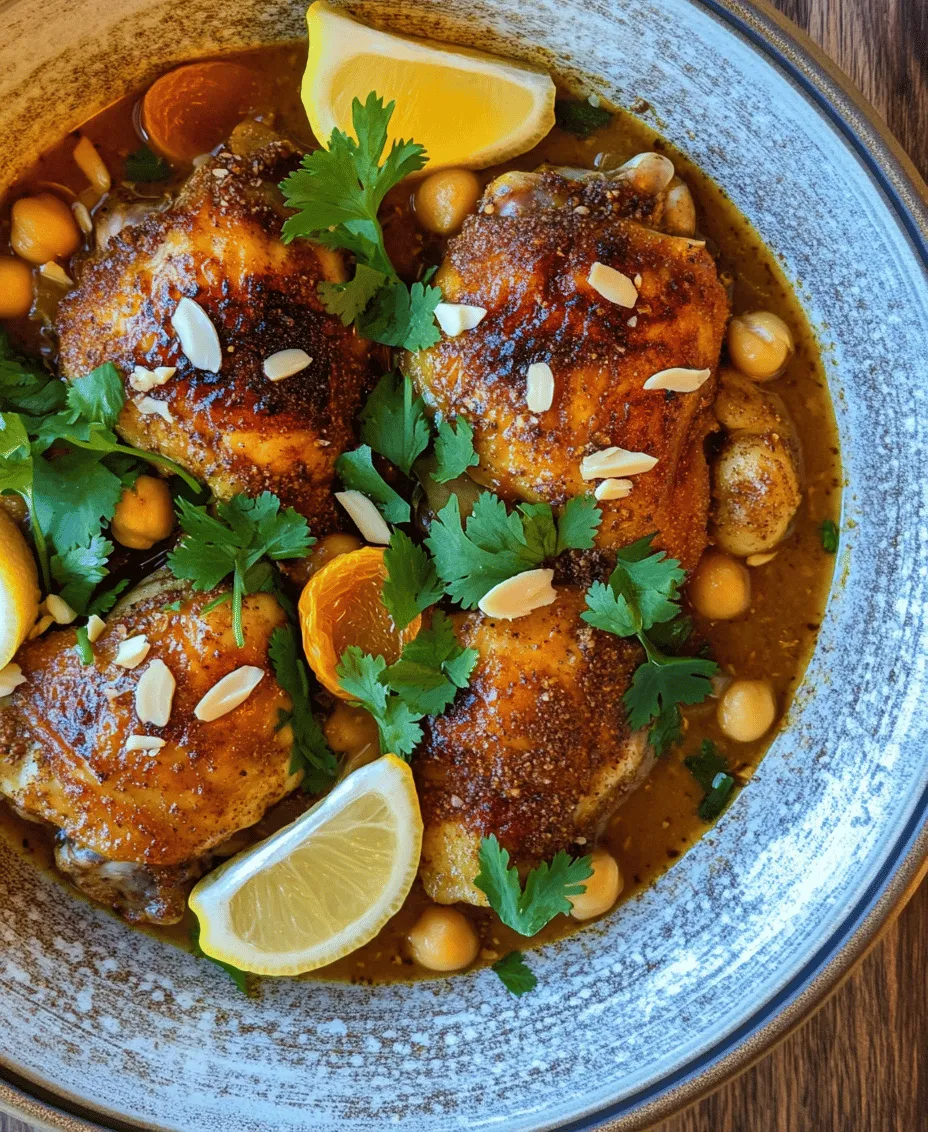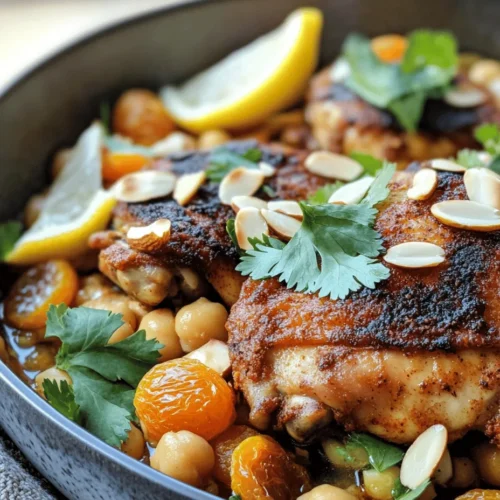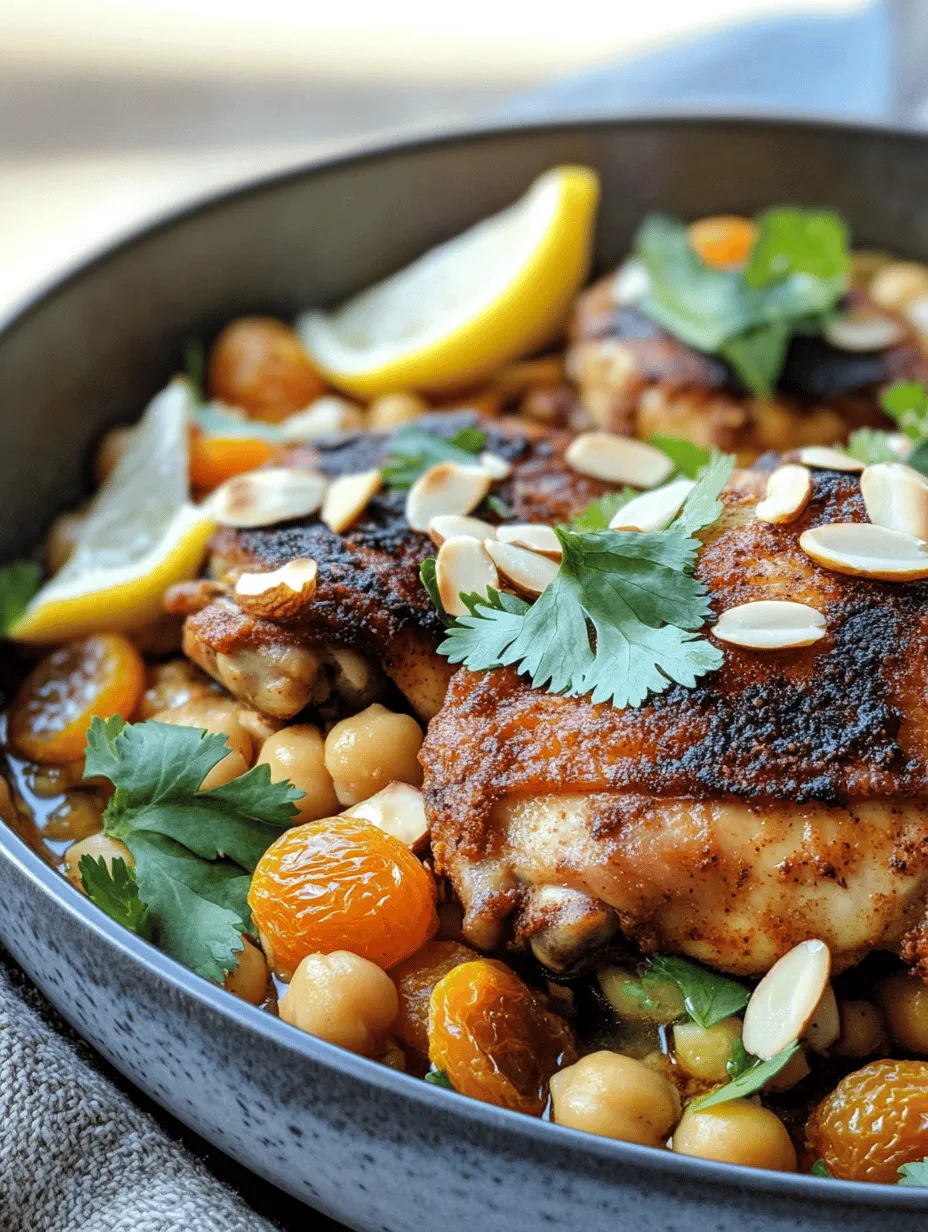Introduction
Moroccan cuisine is a vibrant tapestry of flavors, aromas, and colors, celebrated for its unique blend of spices and cooking techniques. This North African culinary tradition is deeply rooted in its history, influenced by a variety of cultures including Berber, Arab, and Mediterranean. One dish that perfectly encapsulates the essence of Moroccan cooking is Moroccan Spiced Chicken. This recipe not only highlights the importance of spices but also showcases the use of complementary ingredients like chickpeas and dried apricots, elevating the dish to new heights of flavor and texture.
Spices play a crucial role in Moroccan cuisine, transforming simple ingredients into aromatic, rich meals. The careful combination of spices creates a harmonious balance that enhances the natural flavors of chicken, making it tender and succulent. In this Moroccan Spiced Chicken recipe, a blend of warm spices envelops chicken thighs, which are then cooked to perfection alongside hearty chickpeas and sweet dried apricots, resulting in a dish that is as nourishing as it is delicious.
Whether you’re looking for a comforting weeknight dinner or a standout dish for entertaining guests, Moroccan Spiced Chicken is sure to impress. Its rich and complex flavors invite you to explore the culinary traditions of Morocco right from your kitchen.
Understanding Moroccan Spices
At the heart of any great Moroccan dish lies a carefully curated array of spices, each contributing its unique flavor profile and health benefits. In this recipe, we will be using several key spices: cumin, coriander, smoked paprika, cinnamon, turmeric, and cayenne pepper.
– Cumin: Known for its warm, earthy aroma, cumin adds depth to dishes. It is rich in antioxidants and has been linked to several health benefits, including improved digestion and enhanced immune function.
– Coriander: This spice offers a citrusy flavor that brightens the dish. Coriander seeds are also known for their anti-inflammatory properties and can help lower blood sugar levels.
– Smoked Paprika: Adding a smoky flavor and vibrant red color, smoked paprika is a staple in many Moroccan dishes. It is rich in vitamin A and antioxidants, which can help protect the body from oxidative stress.
– Cinnamon: With its sweet and warm flavor, cinnamon is not only a delicious addition but also packed with health benefits. It has been shown to lower blood sugar levels and has anti-inflammatory properties.
– Turmeric: Known for its bright yellow color and earthy taste, turmeric contains curcumin, which has powerful anti-inflammatory and antioxidant effects. It is often used for its health benefits, including improved brain function and lower risk of heart disease.
– Cayenne Pepper: This spice adds a kick of heat, balancing the sweetness of dried apricots and providing a wonderful contrast. Cayenne is also known to boost metabolism and improve digestion.
To achieve an authentic Moroccan flavor, sourcing quality spices is essential. Look for whole spices when possible, as they retain more flavor and aroma. You can find authentic Moroccan spices at specialty grocery stores, spice shops, or online retailers. When purchasing, opt for organic and sustainably sourced options to ensure the best flavor and quality.
Ingredients Breakdown
Creating the perfect Moroccan Spiced Chicken requires a selection of high-quality ingredients. Here’s a detailed breakdown of each ingredient used in the recipe, along with tips to ensure you achieve the best results.
– Chicken Thighs: For this dish, skin-on and bone-in chicken thighs are recommended. They are more flavorful and tender compared to chicken breasts, making them ideal for slow cooking. The skin renders down during cooking, contributing to a rich sauce that coats the chicken beautifully.
– Chickpeas: Canned or cooked chickpeas add heartiness to the dish and pair well with the spices. They bring a nutty flavor and a creamy texture that complements the chicken. For a vegetarian alternative, you could substitute chickpeas with lentils, which also provide protein and fiber.
– Dried Apricots: These add a natural sweetness that balances the savory spices. Dried apricots are not only flavorful but also rich in vitamins A and C, potassium, and fiber. If you prefer, you can replace them with dried figs or raisins for a different sweetness profile.
– Onions: Onions form the base of the flavor profile. They caramelize beautifully when sautéed, adding sweetness and depth to the dish. Yellow or red onions work well in this recipe.
– Garlic: Fresh garlic enhances the overall flavor and brings a pungent aroma that complements the spices. It is best to use fresh garlic cloves rather than pre-minced options for the best taste.
– Tomato Paste: This ingredient adds a rich umami flavor and helps to thicken the sauce, providing a luxurious texture to the dish.
– Chicken Broth: Using low-sodium chicken broth will prevent the dish from becoming overly salty. The broth adds moisture and depth to the cooking liquid.
– Olive Oil: A good-quality olive oil is essential for sautéing and marinating. It also adds healthy fats and enhances the overall flavor of the dish.
– Fresh Herbs: Fresh cilantro or parsley can be used as a garnish, adding brightness and freshness to the final dish.
When selecting your ingredients, aim for the freshest options. Quality ingredients not only enhance the flavor but also contribute to the overall success of the dish.
Marination Process
Marinating the chicken is a crucial step in developing the deep flavors characteristic of Moroccan cuisine. The spices need time to infuse the chicken, resulting in a tender and flavorful dish. Here’s how to properly marinate chicken thighs for this recipe.
Step-by-Step Guide to Marinating Chicken Thighs:
1. Prepare the Marinade: In a large mixing bowl, combine the spices—cumin, coriander, smoked paprika, cinnamon, turmeric, cayenne pepper, minced garlic, and a pinch of salt and pepper. Add a few tablespoons of olive oil to create a paste-like consistency.
2. Coat the Chicken: Add the chicken thighs to the bowl, ensuring each piece is thoroughly coated with the spice mixture. Rub the marinade into the meat to ensure every crevice is filled with flavor.
3. Incorporate Additional Ingredients: If desired, mix in chopped dried apricots and chickpeas into the marinade for added sweetness and texture.
4. Cover and Refrigerate: Once the chicken is well-coated, cover the bowl with plastic wrap or transfer the mixture to a resealable bag. Allow the chicken to marinate in the refrigerator for at least 1 hour, but ideally overnight. This extended marination time allows the flavors to penetrate the meat more deeply.
5. Bring to Room Temperature: Before cooking, let the marinated chicken sit at room temperature for about 30 minutes. This helps the chicken cook evenly.
Marinating is not just about flavor; it also helps to tenderize the chicken, ensuring a juicy and delicious final result. The recommended marination time of at least one hour allows the spices to work their magic, but for the best flavor, marinate overnight.
Searing the Chicken
Searing the chicken is an essential step that adds a layer of complexity to the dish. When you sear chicken thighs, you’re not just cooking them; you’re creating a beautiful golden crust that enhances the flavor profile. Here’s how to achieve that perfect sear.
Tips for Searing Chicken Thighs:
1. Preheat the Skillet: Start by heating a large, heavy skillet over medium-high heat. Adding the chicken to a hot skillet ensures that it will sear rather than steam.
2. Add Oil: Pour in a tablespoon of olive oil and swirl it around to coat the bottom of the skillet. This helps prevent sticking and encourages browning.
3. Place Chicken Skin-Side Down: Carefully place the marinated chicken thighs in the skillet, skin-side down. Avoid overcrowding the pan, as this can lower the temperature and prevent proper searing.
4. Don’t Move the Chicken: Allow the chicken to cook undisturbed for about 5-7 minutes. This will give it time to develop a crispy skin. Once you see a golden crust forming, carefully flip the chicken over to sear the other side.
5. Finish Cooking: The chicken thighs should be seared on both sides and then removed from the skillet. They will finish cooking in the sauce later on, so you don’t need to worry about fully cooking them just yet.
Using the same skillet for the subsequent steps is key, as it retains the fond—those delicious browned bits left behind from searing. This fond will contribute to the richness of the sauce later in the cooking process.
Sautéing the Onions
Once the chicken is seared, the next step is to sauté the onions. This technique is vital as it builds the flavor base for the entire dish. Sautéing onions caramelizes their natural sugars, resulting in a sweet, savory flavor that enhances the overall profile of the Moroccan Spiced Chicken.
How to Sauté Onions for Maximum Flavor:
1. Use the Same Skillet: After removing the chicken, reduce the heat to medium and add a bit more olive oil to the skillet if necessary. The oil will help in sautéing the onions without burning the fond.
2. Add the Onions: Toss in the sliced onions and stir to coat them with the oil. Spread them out evenly in the skillet to ensure they cook uniformly.
3. Cook Slowly: Allow the onions to cook for about 5-8 minutes, stirring occasionally. The goal is to caramelize rather than brown them. If they start to brown too quickly, reduce the heat slightly.
4. Add Seasoning: As the onions soften and turn translucent, you can sprinkle a pinch of salt to help draw out moisture and enhance the flavor.
5. Deglaze if Needed: If the fond looks like it’s starting to stick or burn, you can splash a bit of chicken broth into the skillet to deglaze, scraping up those flavorful bits as the onions finish sautéing.
By taking the time to properly sauté the onions, you’ll create a rich base that complements the spices and chicken beautifully, ensuring a well-rounded dish.
—
By following these steps, you will be well on your way to creating a delicious Moroccan Spiced Chicken that captivates the senses and brings the vibrant flavors of Morocco to your table. Stay tuned for the next part of the recipe, where we will delve into the cooking process and how to bring all the components together for a truly unforgettable meal.

How to Scrape Up Browned Bits for Added Depth in the Sauce
One of the secrets to creating a rich and flavorful sauce for your Moroccan Spiced Chicken lies in scraping up the browned bits that cling to the bottom of your cooking vessel after searing the chicken. These bits, known as fond, are packed with flavor and can significantly enhance your sauce.
To effectively scrape up the fond, follow these steps:
1. Deglazing the Pan: After removing the chicken from the pan, reduce the heat to medium. Add a splash of chicken broth or water to the pan. The liquid will help to loosen the browned bits. Use a wooden spoon or spatula to gently scrape the bottom of the pan, incorporating the fond into the liquid. This process not only adds depth to your sauce but also ensures that none of that delicious flavor goes to waste.
2. Incorporating the Liquid: Once you’ve deglazed the pan, allow the liquid to simmer for a minute or two to concentrate the flavors. This step will create a robust base for your sauce, forming a harmonious blend with the other ingredients you will add next.
Building the Sauce
Now that you’ve created a flavorful base, it’s time to build the sauce. Follow these step-by-step instructions to combine your ingredients effectively:
1. Add Chicken Broth: Pour in the deglazed chicken broth. This liquid will act as the foundation, providing moisture and flavor to the dish. The broth should ideally be low-sodium to allow you to control the seasoning more effectively.
2. Incorporate Chickpeas: Next, add canned chickpeas (drained and rinsed). Chickpeas not only contribute to the heartiness of the dish but also add protein and fiber. They absorb the spices and flavors of the sauce beautifully, making each bite satisfying.
3. Mix in Dried Apricots: Finally, add chopped dried apricots. These fruits introduce a natural sweetness that balances the spices and savory elements of the dish. The apricots will soften as they cook, infusing the sauce with a subtle sweetness that complements the spices.
Adjusting Seasoning and Consistency:
At this point, taste the sauce and adjust the seasoning as necessary. You can add more salt, pepper, or spices according to your preference. If the sauce appears too thick, consider adding a bit more chicken broth or water to reach your desired consistency. Conversely, if it’s too thin, let it simmer uncovered for a few extra minutes to reduce and thicken.
Braising the Chicken
Braising is the key technique that ensures your chicken turns out tender and flavorful. Here’s how to braise effectively:
1. Return the Chicken to the Pan: After building your sauce, nestle the seared chicken pieces back into the pan. Ensure they are submerged in the sauce as much as possible, allowing the flavors to penetrate the meat.
2. Cover and Cook: Cover the pan with a lid and reduce the heat to low. This method traps steam and moisture, which is crucial for tenderizing the chicken.
3. Cooking Time: Allow the chicken to braise for about 30-40 minutes, depending on the thickness of the chicken pieces. You’ll know the chicken is done when it reaches an internal temperature of 165°F (75°C) and is fork-tender.
4. Lid On vs. Lid Off: Cooking with the lid on will keep the moisture in, resulting in more tender chicken. If you prefer a slightly thicker sauce, you can remove the lid for the last 10 minutes of cooking to allow the sauce to reduce further.
Finishing Touches
As your Moroccan Spiced Chicken nears completion, it’s time to add the finishing touches that elevate the dish:
1. Add Slivered Almonds: About five minutes before serving, sprinkle in slivered almonds. These not only add a delightful crunch but also enhance the nutty flavor profile of the dish.
2. Toasting the Almonds: To toast the almonds without burning them, keep an eye on them as they cook in the residual heat of the dish. Stir them gently to ensure they toast evenly. If you notice them browning too quickly, reduce the heat.
3. Garnishing and Serving: Once the chicken is done, consider garnishing with fresh herbs like cilantro or parsley for a pop of color and freshness. A sprinkle of lemon juice just before serving can also brighten the flavors.
Serving Suggestions
Pairing your Moroccan Spiced Chicken with the right accompaniments can enhance the overall dining experience:
1. Ideal Accompaniments: Serve the chicken over a bed of fluffy couscous, which will soak up all the delicious sauce. Alternatively, warm pita bread is perfect for scooping up the chicken and sauce, adding a delightful texture to each bite.
2. Plating the Dish: Present the chicken on a large platter, surrounded by the sauce, chickpeas, and apricots. Scatter the toasted almonds and fresh herbs on top for an appealing visual presentation. Ensure the couscous or pita is neatly arranged on the side.
3. Beverage Pairings: Complement your meal with a refreshing beverage. A chilled white wine, such as Sauvignon Blanc or a light-bodied red like Pinot Noir, pairs wonderfully with the spices. For a non-alcoholic option, consider serving mint tea to echo the Moroccan theme.
Nutritional Information
Understanding the nutritional benefits of your ingredients can help you appreciate this dish even more:
1. Nutritional Overview: Moroccan Spiced Chicken is a balanced meal rich in protein, fiber, and essential vitamins and minerals. Chicken provides lean protein, while chickpeas are an excellent source of plant-based protein, fiber, and complex carbohydrates.
2. Health Benefits of Ingredients: The spices used, such as cumin and coriander, have anti-inflammatory properties, while dried apricots are packed with vitamins A and C, potassium, and antioxidants. Almonds contribute healthy fats, protein, and vitamin E, making this dish not just delicious but nutritious.
3. Balanced Diet: Enjoying Moroccan Spiced Chicken fits well into a balanced diet, as it includes a variety of food groups and is relatively low in saturated fats when prepared with lean chicken. This dish can be especially beneficial as part of a meal plan aiming for wholesome nutrition.
Conclusion
In summary, Moroccan Spiced Chicken is a delightful culinary experience that combines rich flavors, tender chicken, and a balance of spices that transport your taste buds to North Africa. The careful braising technique, along with the thoughtful combination of ingredients, creates a dish that is both satisfying and nourishing.
We encourage you to try making this dish at home, as it presents an opportunity to explore the vibrant flavors of Moroccan cuisine. Cooking can be a joyful journey of discovery, allowing you to experiment with diverse ingredients and cooking methods. As you savor your homemade Moroccan Spiced Chicken, embrace the joy of cooking and the magic of creating culinary experiences that bring friends and family together around the table.



